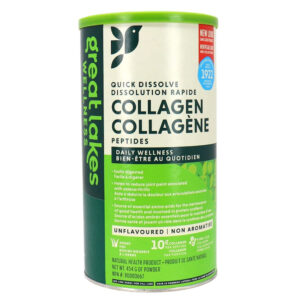What You Need to Know About Collagen
Ever heard the saying “old horses get sent to the glue factory”? For 8,000 years tendons, ligaments and hides of dead horses have been used to make glue. All those connective tissues contain a key ingredient that can be made into a gelatin that’s sticky when it’s wet and hardens when it dries. Collagen, that key ingredient, also happens to be the most abundant protein in your body.
The word collagen derives from the Greek kolla, which means glue, and the suffix –gen, which means producer. This same collagen that’s in large mammals makes up about 30 percent of your protein mass. It’s the major structural protein in tendons, ligaments, cartilage, skin, blood vessels, muscles, and gut tissue. Collagen keeps your bones and joints healthy, and it also keeps your skin and hair looking good. Collagen is the biological glue that holds everything together.
Why We Don’t Get Enough Collagen

Your body makes the collagen you need from three key amino acids: glycine, proline, and hydroxyproline. We find these amino acids in meats, eggs, and beans. But they are truly abundant in the cartilage, tendons, and skins of animals. Our ancestors, even as recent as our grandparents, ate all the parts of animals, especially the meat and cartilage around the bones. They even ate the tail and tongue and used bones to make soups and stews.
In our modern world of boneless, skinless chicken breasts, we don’t eat much collagen. We eat the best cuts of meat and throw away the fat. Nobody eats the meat next to the bone, and heaven forbid we leave the skin on the chicken.
Your body’s production of collagen slows as you age. Collagen loss in the body starts at 18-29 years of age. After 40 years, the human body can lose around 1% of its collagen per year. By the time a person reaches 80, collagen production in the skin may have decreased by 75 percent.
Lifestyle- and age-related loss of collagen will take its toll on the way you look and feel. The strength and elasticity of your tendons and ligaments, the health of your blood vessels, and the look and feel of your skin and hair all depend on collagen. Let’s dive a little deeper to understand the benefits of collagen and the best ways for you to get more.
Types Of Collagens
There are twenty-eight distinct collagen proteins. Collagens I, II, and III, the most abundant collagen types, are representative of the area of the body where we find the collagen.
Type I Collagen is the most prevalent collagen in the body. It’s present in skin, bones, teeth, tendons, ligaments, blood vessels, and organs.
Type II Collagen is present in cartilage.
Type III Collagen is found in skin, hair, and blood vessels.
I’m a big fan of collagen supplements, but keep in mind that most of them are composed of type I and type II collagen. That’s great because your skin is about 85% type I and 15% type II. But there’s probably a need in your diet for the other 26 collagen types. So, getting as much collagen as you can in your diet is important as well.
How to Get More Collagen in Your Diet
Animals contain lots of protein and a wide array of amino acids, but we don’t eat animals. Most of us eat lean cuts of meat, getting rid of the skin, connective tissue, cartilage, tendons, and bones. We find the amino acids we need to produce collagen, particularly glycine, in the connective tissues of animals. Here are a few tips to help you get the most out of your meat.

Clean Your Bones. All the stuff attached to the bones that we usually throw away is cartilage and tendons. It’s all made of collagen. Eat it—especially that stuff attached to rib bones.
Eat skin. Skin—your skin and animal skin—is 90 percent collagen. Buy poultry with the skin on and eat it. Pork rinds are made of pig skin, and the right ones are a lot better for you than chips. My favorite is Epic Pork Rinds. Try the Chili Lime—you’ll thank me.
Drink Bone Broth. Bone broth has regained popularity because we understand how much collagen it contains. Save the bones from your meat, make your own broth and drink it. If you don’t have time for that, try Bare Bones Instant Bone Broth.
Should You Supplement with Collagen?
I consume collagen from hydrolyzed collagen peptides every day. Even though I chew on steak bones and eat chicken skin, I know I’m not getting as much collagen as my ancestors did. Hydrolyzed simply means water was used to break the amino acids into short chains called peptides. Research shows that these peptides can actually be absorbed and make their way intact to cartilage. I’m all for that.
Collagen Peptides Are Great for Your Joints
One study involving patients with rheumatoid arthritis found supplementation of cartilage-derived type II collagen produced a 30 percent reduction in swollen and tender joints. Another study published in Science involving 60 patients with rheumatoid arthritis found a significant reduction in swollen and tender joints in subjects fed type II collagen for three months. Four patients in the study experienced complete remission of their arthritis.
Collagen supplementation led to improvements in young athletes as well. A study conducted in 2008 found that supplementing with collagen for 24 weeks reduced sports related joint pain in athletes.
Your Skin Needs Collagen
The dry weight of your skin is 90 percent collagen. If you want your skin to look healthy and less wrinkly, supplementing with collagen peptides can help.
A study published in 2012 found that in 26 healthy females who displayed visible signs of natural and photoaging in the face, daily supplementation of collagen powder for 12 weeks led to a 76% reduction of skin dryness/scaling and a 13% decrease in global lines and wrinkles. Additionally, patients had an 18% increase in the hemoglobin content in the skin, which suggests increased circulation.
Just a couple of months ago, a meta-analysis of 26 randomized controlled trials involving 1,721 patients found that hydrolyzed collagen supplementation significantly improved skin hydration and elasticity compared to placebo.
Even cellulite can be reduced after 6 months of collagen supplementation.
Collagen Might Even Prevent Diabetes
Glycine is the most abundant amino acid in collagen. Red meat contains low levels of glycine and higher levels of methionine. Researchers have shown that red meat consumption can increase the risk of diabetes, but studies that control for low glycine status show no risk at all. People with low glycine levels and high meat intakes were more likely to have diabetes, while people with higher glycine levels could have higher meat intakes without any issues.
Another study found that low circulating levels of glycine predicted diabetes risk, while high levels of glycine predicted normal blood sugar. Low glycine levels usually occur before the onset of diabetes, suggesting glycine status could be a cause of diabetes.
How to Supplement with Collagen
 I typically add 20 grams of collagen to my coffee in the morning. Collagen does not dissolve well in cold water. Putting collagen in coffee is a great option because most collagen powders are odorless and tasteless. My two favorite brands are Great Lakes and Vital Proteins. If you’re having trouble falling asleep at night, try 10 grams of collagen mixed with hot water. Drink it like an evening tea. It will improve the quality of your sleep.
I typically add 20 grams of collagen to my coffee in the morning. Collagen does not dissolve well in cold water. Putting collagen in coffee is a great option because most collagen powders are odorless and tasteless. My two favorite brands are Great Lakes and Vital Proteins. If you’re having trouble falling asleep at night, try 10 grams of collagen mixed with hot water. Drink it like an evening tea. It will improve the quality of your sleep.
Powdered gelatin is also a great way to get more collagen. You should always keep some around to experiment with making different sauces and gravies. Zen Principle makes an awesome grass-fed & pasture-raised beef gelatin.
If your joints ache or your skin is starting to sag, give collagen a try. Make sure you give it at least three months. Most studies that saw significant benefits lasted three months or longer.
Oh, and don’t throw those chicken skins away.
Stay Strong,
Bo Railey

